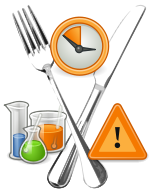Danger zone (food safety)
- Danger zone (food safety)
-
The temperature range in which food borne bacteria can grow is known as the danger zone. According to the 2009 U.S. Food and Drug Administration Food Code, the danger zone is defined as 41°F - 135°F (5°C - 57°C). [1] However, other jurisdictions consider the danger zone between 40°F - 140°F (5°C - 58°C). [2] Potentially hazardous food should not be stored at temperatures in this range in order to prevent foodborne illness, and food that remains in this zone for more than four hours must be discarded. Foodborne microorganisms grow much faster in the middle of the zone, at temperatures between 70°F and 135°F (21°C and 52°C). Clostridium perfringens and Bacillus cereus grow very rapidly in food in the danger zone and cause different illnesses. Time and temperature control plays a critical role in food safety. To prevent time-temperature abuse, minimize the amount of time food spends in the danger zone. [3]
References
See also
Wikimedia Foundation.
2010.
Look at other dictionaries:
Danger Zone — may refer to: In film, television and video games: Danger Zone (Gladiators) or Assault, an event on the TV series Gladiators Jurassic Park III: Danger Zone! (video game), a 2001 game Literature The Danger Zone (book series) or You Wouldn t Want… … Wikipedia
Agriculture and Food Supplies — ▪ 2007 Introduction Bird flu reached Europe and Africa, and concerns over BSE continued to disrupt trade in beef. An international vault for seeds was under construction on an Arctic island. Stocks of important food fish species were reported… … Universalium
Portal:Food — Wikipedia portals … Wikipedia
Potentially Hazardous Food — is a term used by food safety organizations to classify foods that require time temperature control to keep them safe for human consumption. A PHF is a food that: *Contains moisture usually regarded as a water activity greater than 0.85 *Contains … Wikipedia
Laser safety — A typical laser warning symbol. Laser safety is safe design, use and implementation of lasers to minimize the risk of laser accidents, especially those involving eye injuries. Since even relatively small amounts of laser light can lead to… … Wikipedia
Nuclear safety — covers the actions taken to prevent nuclear and radiation accidents or to limit their consequences. This covers nuclear power plants as well as all other nuclear facilities, the transportation of nuclear materials, and the use and storage of… … Wikipedia
Hayward Fault Zone — The Hayward Fault Zone is a geologic fault zone capable of generating significantly destructive earthquakes. About 60 kilometers long, it lies mainly along the western base of the hills on the east side of San Francisco Bay. It runs through… … Wikipedia
Chernobyl Nuclear Power Plant Exclusion Zone — Coordinates: 51°18′0″N 30°0′18″E / 51.3°N 30.005°E / 51.3; 30.005 … Wikipedia
Cooking — This article is about the preparation of food by heating. For food preparation generally, see Food preparation. Modern fruit salad and a Russian cigarette pastry stuffed with cottage cheese Cooking is the process of preparing food by use of heat … Wikipedia
United States — a republic in the N Western Hemisphere comprising 48 conterminous states, the District of Columbia, and Alaska in North America, and Hawaii in the N Pacific. 267,954,767; conterminous United States, 3,022,387 sq. mi. (7,827,982 sq. km); with… … Universalium

